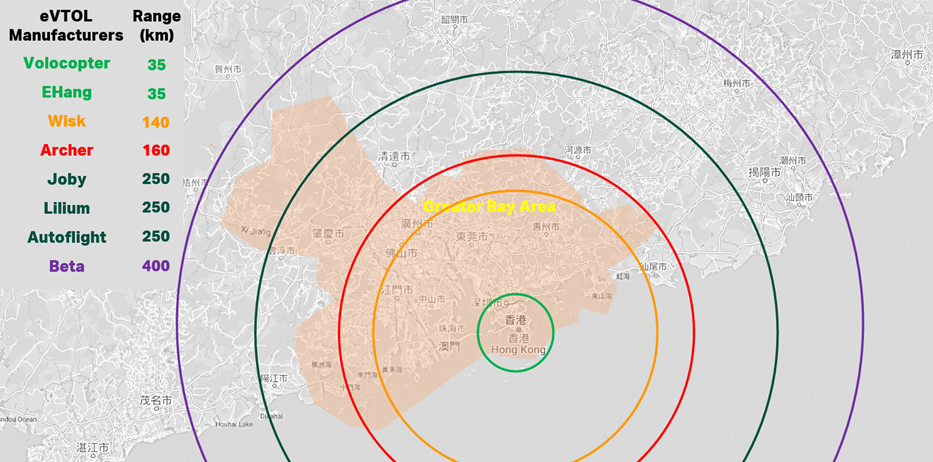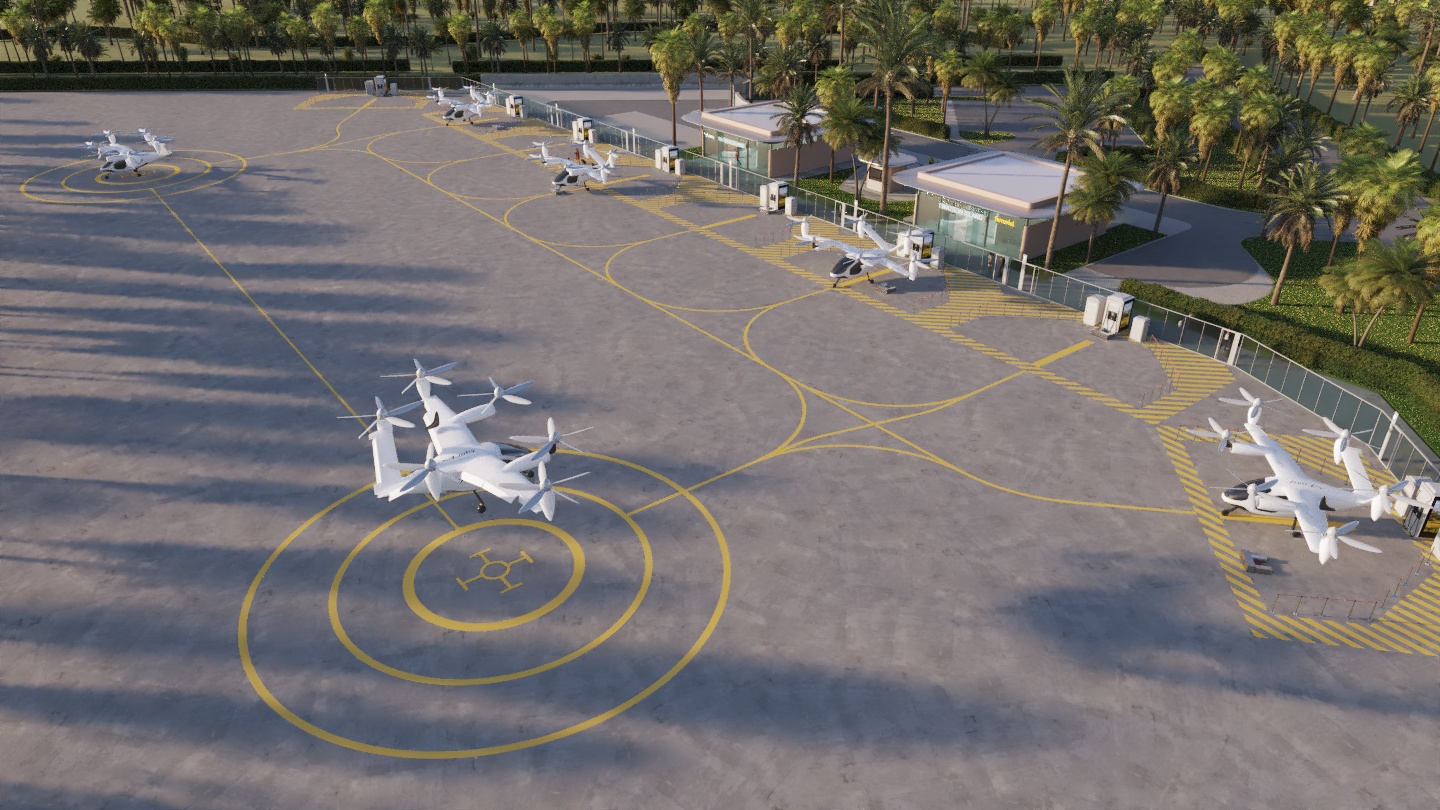Securing take-off for the low-altitude economy: Advanced Air Mobility in Hong Kong and the Greater Bay Area
Electric Vertical Take-off and Landing aircraft promise to transform urban mobility across the Greater Bay Area, offering a safe, sustainable and efficient transport solution.
The need for travel efficiency and environmental sustainability has brought us closer than ever to realizing a concept that seemed futuristic merely a decade ago: flying cars. This breakthrough has been enabled by Advanced Air Mobility (AAM), a safe, automated, electric and accessible system to transport passengers, cargo and other operations, through the air.
Specifically, electric Vertical Take-off and Landing (eVTOL) aircraft have started to disrupt conventional travel methods. Leveraging advancements in Distributed Electric Propulsion (DEP) and battery technology, these aircraft combine the features of drones, helicopters and conventional aircraft to efficiently move people and goods. They are particularly suitable for tackling congestion and providing a more sustainable transportation solution in urban environments such as Hong Kong and the Greater Bay Area (GBA).
With the increasing demand for smarter, faster and more cost-effective solutions to manage urban mobility and logistics, now is the time to start considering how to integrate eVTOLs into our transport systems. The GBA, with its dynamic economy and rapid urbanization, is an ideal testing ground for innovations. So how can this vision be turned into reality?
Gathering momentum of eVTOL and Urban Air Mobility
We are currently witnessing a surge of interest in eVTOLs, with over 1,100 different concepts being developed worldwide. Governments and cities around the world are also actively promoting the technology. For instance, the development of the ‘low-altitude economy’ — defined as economic activities conducted in airspace below 1,000 meters — was highlighted in the Hong Kong Chief Executive’s 2024 Policy Address, with eVTOLs set to play a central role.
Elsewhere in the GBA, the Shenzhen government implemented China’s first legal framework for promoting this economy, which aims to create a comprehensive network of approximately 1,200 take-off and landing points for both eVTOLs and drones by the end of 2026. This would include associated communication and sensor infrastructure.
The opportunity for Urban Air Mobility (UAM), a subset of AAM that specifically focuses on urban environments, is also sizeable. Research from Morgan Stanley forecasts that the total addressable market for UAM is set to reach approximately US$1 trillion in 2040, but will then boom to US$9 trillion by 2050 — representing around five to six percent of the projected global GDP.
Transforming travel: Potential benefits in Hong Kong and the GBA
The cruising range of eVTOLs varies by their design, size and intended use. Some eVTOL models are suitable for intra-city transport, while others could be used for serving inter-city transport needs. The following provides an illustration of the range that eVTOLs could provide from Hong Kong, demonstrating their ability to reach cities within the GBA on a single charge:

To highlight the benefits that eVTOLs can bring, an intra-city journey in Hong Kong from Central to the future San Tin Technopole in the Northern Metropolis could take approximately 10 minutes — 80 percent less time than using a taxi during peak hours. Similarly for inter-city travel across the GBA, a trip from Central to the city of Foshan, could take approximately 40 minutes via eVTOL, down from around four hours via conventional means such as a cross-border bus.
These time savings do not only enhance the efficiency of daily travel, but will also improve productivity and quality of life for individuals. By offering faster and more convenient travel options, eVTOLs thus have the potential to revolutionize transportation and improve mobility for residents and visitors in the GBA.
Infrastructure design considerations for the low-altitude economy
In the next five years, limited premium eVTOL services for high-end transportation needs will be offered as a complement to existing modes of transport. However, adoption is expected to become more widespread after 2030 as more people recognize the benefits of UAM. This will require an expanded network of vertiports, as well as associated infrastructure such as air traffic management systems.
In working towards the successful implementation of eVTOL, AECOM is already collaborating closely with eVTOL industry stakeholders around the world, including the National Aeronautics and Space Administration (NASA) in the US and clients in the Middle East and Asia. Our expertise in integrating various components, such as energy systems, enables us to optimize eVTOL operations and facilitate their effective implementation in urban landscapes.

Based on our involvement in eVTOL infrastructure in projects around the world. including studies in the Northern Metropolis, we have identified 10 key factors that must be considered in the design of vertiports for Hong Kong:
1. Strategic Location: Integration of eVTOLs into existing transport networks for inter-modal connectivity.
2. Vertiport Size and Layout: Compatibility with different models of eVTOLs.
3. Spatial Requirements: Air space separation from other traffic (e.g. conventional aircraft, helicopters, drones) through air traffic management systems.
4. Charging Infrastructure: Provision of power for eVTOLs’ charging needs.
5. Safety Measures: Fire protection systems and other emergency measures.
6. Environmental Considerations: Noise and impact on migratory birds.
7. Passenger Experience: Ensuring simplicity, speed, and convenience.
8. Scalability: Modular and adaptable designs for high-frequency operations.
9. Security: Physical and cybersecurity against unauthorized access and potential threats.
10. Visual Pollution and Privacy: Addressing concerns of operating eVTOLs in urban areas.
Advancing eVTOL integration
Our experience in AAM, vertiport designs, sustainable technologies and transport planning has enabled us to overcome multiple challenges associated with eVTOL technology to deliver safe, efficient and sustainable transport solutions. The technology has the potential to transform the transport landscape of Hong Kong and the Greater Bay Area. In this regard, the launch of Hong Kong’s Low-altitude Economy Regulatory Sandbox as well as legislative amendments to support implementation of the low-altitude economy mark a significant step forward, enabling the city to trial eVTOL applications that could redefine urban mobility. Together, these initiatives will not only secure the take-off of the low-altitude economy in Hong Kong, but also foster closer integration and collaborative development across the GBA.






